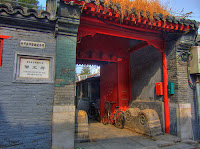Chapter Three
A hidden treasure in Beijing: Nanluoguxiang
Compared to the fast and rhythmic lives of the Beijing people, Nanluoguxiang is a place where hurrying does not happen.
 |
| Nanluoguxiang |
Stretching several kilometers north of the Forbidden City and just east of Houhai Lake, there is an 800-meter long north-south alleyway which was built in 1267 filled with cafes, bars, and shops all designed in classical Chinese 'hutong' style—Nanluoguxiang.
Nanluoguxiang is the only remaining traditional residential area in China that still fully preserves the chess-board style layout of Hutongs typically found in the Yuan Dynasty, with its scale, quality and historical value unmatched by any other lanes.
In old Beijing’s history, Nanluoguxiang was mainly a protected street of traditional courtyard homes called Siheyuan. It was built under the architectural concept of "residential blocks" -- with the lane serving as the axis dividing 8 parallel hutongs on each side. The lane is so neat that it looks like a centipede. This is where it got its second name, "Centipede Street."
Moreover, Nanluoguxiang is a neighborhood which has traditionally housed merchants, the wealthy and the powerful and it is well on its way to reclaiming that heritage today. The walls and tiles on Nanluoguxiang are a grayish tone, not the royal red of the Forbidden City just one street away. The court officers and literates used to live on this street.
The following three places mentions are the most famous in Nanluoguxiang with their historical sedimentary deposits.
1. Prince Seng's Mansion
 |
| Prince Seng's Mansion |
2. Mao'er Hutong
 |
Mao'er Hutong
|
3. Ju'er Hutong
Ju'er Hutong is in the north of Nanluoguxiang. Famous for its reconstruction project of dilapidated buildings, Ju'er Hutong was awarded "Asian Gold Asian Architecture" by Architects Regional Council Asia in 1992 and "World Habitat Awards" in 1993.
 |
| Ju'er Hutong |
A small group of courtyard formed by buildings with 2 or 3 floors is sitting in the middle of Ju'er Hutong. Combining together the elegant features of Jiangnan architecture styles and the verve of traditional Quadrate Yard, these new buildings are in harmony with the constructions around.
The Modern time of Nanluoguxiang
The lane of Nanluoguxiang is now famous for the cafes and bars and clothing and handcraft shops that line its hutong laneways as well as its traditional hutong and courtyards. There are well over 20 restaurants and 40 shops scattered along Nanluoguxiang.
This quaint street boasts many cool shops offering silk shawls, handicrafts designed by local artists, and trendy T-shirts featuring images of everything. Some of interest shops such as:
 |
| Pottery Workshop |
2. So Sweet clothshop at No.110 of Nanluoguxiang
3. Grifted at No. 32 of Nanluoguxiang
4. Plastered T-shirts at No.61 of Nanluoguxiang
5. Shi Jue at No. 17 of Nanluoguxiang
6. Nice Days at No.82 of Nanluoguxiang
In addition, Nanluoguxiang is a mix of history, fashion and culture and it's a big hit with tourists especially the younger generation. It is another bar area besides Houhai Bar Street, Workers’Stadium and Sanlitun Bar Street. But different from those two, Nanluoguxiang Bar Street is much quiet and nature, close to people's life. In a word, Nanluoguxiang is a perfect blend of past and present—
Ubiquitous shops of various characters offer you dining, drink, snack tasting and shopping, every shop or bar here is not very large but interesting with special operation.
Sitting in the traditional quadrate yard, reading a book with a cup of coffee on the table, you will enjoy a different kind of feeling here. Or enjoying a nice tea bar is may be your dream in this lane where you can walk around the Hutong to find it while feeling old Beijing culture.
--All in all, with its impressive historical and cultural legacy, Nanluoguxiang has become a renowned area for tourism and cultural creativity in the ancient capital of Beijing.
No comments:
Post a Comment
Thanks for your comment and welcome to China!